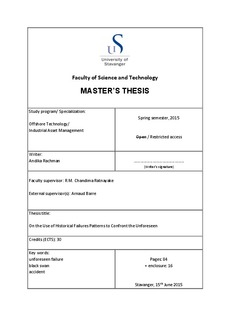| dc.description.abstract | Deepwater Horizon blowout, Bhopal gas tragedy, and Fukushima nuclear accident are some examples of failures that are seemed to be unforeseen and surprising from ones perspectives. The future occurrence of similar events is not tolerable due to the nature of their consequences that are detrimental to the society, environment, and business. Therefore, there must be some approaches that are implemented to prevent and mitigate unforeseen failures. The aim of this thesis is to map the patterns (e.g. factors and conditions) underlying unforeseen failures. The notion comes from the belief that even though failures occurred in different places, different industries, different scenarios, and so on, they have similar patterns that trigger their occurrences. Based on the identified patterns, some methods are proposed as means to encounter unforeseen failures.
The work begins with systematic literature review of several historical unforeseen failures in order to investigate their underlying causes. The reviews will not be limited to the proximate events, i.e. human errors and technical failures, but also causal factors and symptoms that have existed long before the moment of the failures, i.e. social and organizational factors. The premise is that the combination of sound technical, human, and organizational perspective is required to understand the problems causing the failures. Similar factors and/or conditions that underlie each of the historical unforeseen failures are then identified.
Four common patterns that underlie unforeseen failures are identified: (1) dysfunctional and complex interactions between regulatory agencies, company’s management, operators, physical equipment, and other component of the system; (2) ineffective control by regulatory agencies and management failure to uphold safety; (3) the tendency of the management to prioritize profitability over safety generates, creating decisions and actions that are detrimental to the safety of the system; and (4) unrecognized and/or neglected warning signals preceding the failures.
Two general recommendations that are drawn based on the identified patterns. The first one is to use hazard analysis based on systemic accident causation model. The conventional hazard analyses are no longer suitable to be used in highly complex socio-technical system as it overlooks the hazards that are developed from the interactions between components of the system, unsafe decisions and actions by the management and regulator, and organizational factors. Hazard analysis founded on systemic accident causation model should be used to consider the aspects that are overlooked by the traditional hazard analysis techniques. The second recommendation is to adopt proactive risk management approach by implementing leading indicators in the system. The implementation of leading indicators will enable the detection of hazardous operation (including unsafe decisions and actions) in the system and recognizing the important early warning signals that precede a failure. | nb_NO |
